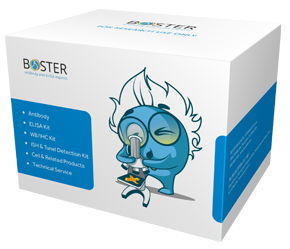Product Info Summary
| SKU: | A01025-2 |
|---|---|
| Size: | 100 μg/vial |
| Reactive Species: | Human |
| Host: | Rabbit |
| Application: | Flow Cytometry, IHC, WB |
Customers Who Bought This Also Bought
Product info
Product Name
Anti-DC-SIGN/CD209 Antibody Picoband®
SKU/Catalog Number
A01025-2
Size
100 μg/vial
Form
Lyophilized
Description
Boster Bio Anti-DC-SIGN/CD209 Antibody Picoband® catalog # A01025-2. Tested in Flow Cytometry, IHC, WB applications. This antibody reacts with Human. The brand Picoband indicates this is a premium antibody that guarantees superior quality, high affinity, and strong signals with minimal background in Western blot applications. Only our best-performing antibodies are designated as Picoband, ensuring unmatched performance.
Storage & Handling
Store at -20˚C for one year from date of receipt. After reconstitution, at 4˚C for one month. It can also be aliquotted and stored frozen at -20˚C for six months. Avoid repeated freeze-thaw cycles.
Cite This Product
Anti-DC-SIGN/CD209 Antibody Picoband® (Boster Biological Technology, Pleasanton CA, USA, Catalog # A01025-2)
Host
Rabbit
Contents
Each vial contains 4mg Trehalose, 0.9mg NaCl, 0.2mg Na2HPO4, 0.05mg NaN3.
Clonality
Polyclonal
Isotype
Rabbit IgG
Immunogen
A synthetic peptide corresponding to a sequence at the N-terminus of human DC-SIGN.
*Blocking peptide can be purchased. Costs vary based on immunogen length. Contact us for pricing.
Cross-reactivity
No cross-reactivity with other proteins.
Reactive Species
A01025-2 is reactive to CD209 in Human
Reconstitution
Add 0.2ml of distilled water will yield a concentration of 500ug/ml.
Observed Molecular Weight
46 kDa
Calculated molecular weight
47579 MW
Background of CD209
DC-SIGN (Dendritic Cell-Specific Intercellular adhesion molecule-3-Grabbing Non-integrin) also known as CD209 (Cluster of Differentiation 209) is a protein which in humans is encoded by the CD209 gene. This gene encodes a transmembrane receptor and is often referred to as DC-SIGN because of its expression on the surface of dendritic cells and macrophages. The encoded protein is involved in the innate immune system and recognizes numerous evolutionarily divergent pathogens ranging from parasites to viruses with a large impact on public health. The protein is organized into three distinct domains: an N-terminal transmembrane domain, a tandem-repeat neck domain and C-type lectin carbohydrate recognition domain. The extracellular region consisting of the C-type lectin and neck domains has a dual function as a pathogen recognition receptor and a cell adhesion receptor by binding carbohydrate ligands on the surface of microbes and endogenous cells. The neck region is important for homo-oligomerization which allows the receptor to bind multivalent ligands with high avidity. Variations in the number of 23 amino acid repeats in the neck domain of this protein are rare but have a significant impact on ligand binding ability. This gene is closely related in terms of both sequence and function to a neighboring gene. DC-SIGN and L-SIGN differ in their ligand-binding properties and distribution. Alternative splicing results in multiple variants.
Antibody Validation
Boster validates all antibodies on WB, IHC, ICC, Immunofluorescence, and ELISA with known positive control and negative samples to ensure specificity and high affinity, including thorough antibody incubations.
Application & Images
Applications
A01025-2 is guaranteed for Flow Cytometry, IHC, WB Boster Guarantee
Assay Dilutions Recommendation
The recommendations below provide a starting point for assay optimization. The actual working concentration varies and should be decided by the user.
Western blot, 0.1-0.5μg/ml
Immunohistochemistry (Paraffin-embedded Section), 0.5-1μg/ml
Flow Cytometry, 1-3μg/1x106 cells
Positive Control
WB: human HepG2 whole cell
IHC: human intestinal cancer tissue, human placenta tissue
FCM: THP-1 cell
Validation Images & Assay Conditions
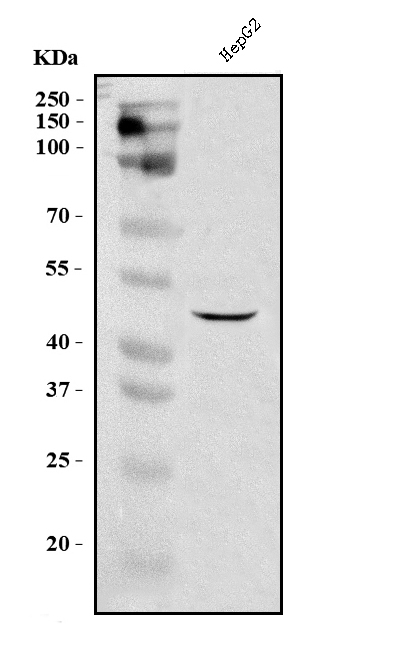
Click image to see more details
Figure 1. Western blot analysis of DC-SIGN using anti-DC-SIGN antibody (A01025-2).
Electrophoresis was performed on a 5-20% SDS-PAGE gel at 70V (Stacking gel) / 90V (Resolving gel) for 2-3 hours. The sample well of each lane was loaded with 30 ug of sample under reducing conditions.
Lane 1: human HepG2 whole cell lysates.
After electrophoresis, proteins were transferred to a nitrocellulose membrane at 150 mA for 50-90 minutes. Blocked the membrane with 5% non-fat milk/TBS for 1.5 hour at RT. The membrane was incubated with rabbit anti-DC-SIGN antigen affinity purified polyclonal antibody (Catalog # A01025-2) at 0.5 μg/mL overnight at 4°C, then washed with TBS-0.1%Tween 3 times with 5 minutes each and probed with a goat anti-rabbit IgG-HRP secondary antibody at a dilution of 1:5000 for 1.5 hour at RT. The signal is developed using an Enhanced Chemiluminescent detection (ECL) kit (Catalog # EK1002) with Tanon 5200 system. A specific band was detected for DC-SIGN at approximately 46 kDa. The expected band size for DC-SIGN is at 46 kDa.
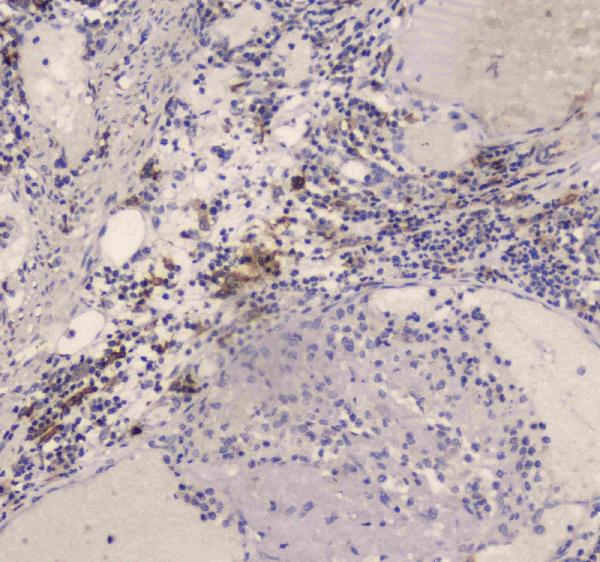
Click image to see more details
Figure 2. IHC analysis of DC-SIGN using anti-DC-SIGN antibody (A01025-2).
DC-SIGN was detected in paraffin-embedded section of human intestinal cancer tissue. Heat mediated antigen retrieval was performed in citrate buffer (pH6, epitope retrieval solution) for 20 mins. The tissue section was blocked with 10% goat serum. The tissue section was then incubated with 1μg/ml rabbit anti-DC-SIGN Antibody (A01025-2) overnight at 4°C. Biotinylated goat anti-rabbit IgG was used as secondary antibody and incubated for 30 minutes at 37°C. The tissue section was developed using Strepavidin-Biotin-Complex (SABC)(Catalog # SA1022) with DAB as the chromogen.
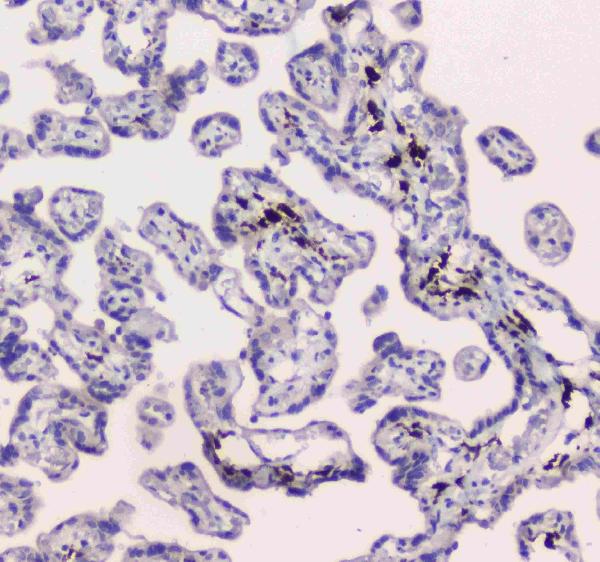
Click image to see more details
Figure 3. IHC analysis of DC-SIGN using anti-DC-SIGN antibody (A01025-2).
DC-SIGN was detected in paraffin-embedded section of human placenta tissue. Heat mediated antigen retrieval was performed in citrate buffer (pH6, epitope retrieval solution) for 20 mins. The tissue section was blocked with 10% goat serum. The tissue section was then incubated with 1μg/ml rabbit anti-DC-SIGN Antibody (A01025-2) overnight at 4°C. Biotinylated goat anti-rabbit IgG was used as secondary antibody and incubated for 30 minutes at 37°C. The tissue section was developed using Strepavidin-Biotin-Complex (SABC)(Catalog # SA1022) with DAB as the chromogen.
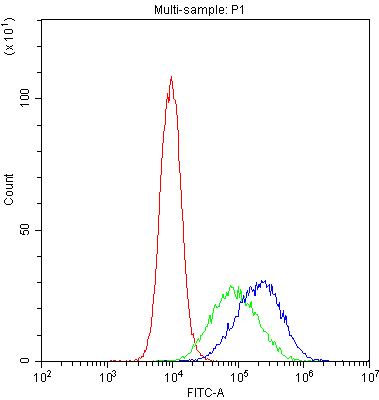
Click image to see more details
Figure 4. Flow Cytometry analysis of THP-1 cells using anti-DC-SIGN antibody (A01025-2).
Overlay histogram showing THP-1 cells stained with A01025-2 (Blue line).The cells were blocked with 10% normal goat serum. And then incubated with rabbit anti-DC-SIGN Antibody (A01025-2,1μg/1x106 cells) for 30 min at 20°C. DyLight®488 conjugated goat anti-rabbit IgG (BA1127, 5-10μg/1x106 cells) was used as secondary antibody for 30 minutes at 20°C. Isotype control antibody (Green line) was rabbit IgG (1μg/1x106) used under the same conditions. Unlabelled sample (Red line) was also used as a control.
Protein Target Info & Infographic
Gene/Protein Information For CD209 (Source: Uniprot.org, NCBI)
Gene Name
CD209
Full Name
CD209 antigen
Weight
47579 MW
Alternative Names
CD209 antigen; C-type lectin domain family 4 member L; Dendritic cell-specific ICAM-3-grabbing non-integrin 1; DC-SIGN; DC-SIGN1; CD209; CD209; CLEC4L CD209 CDSIGN, CLEC4L, DC-SIGN, DC-SIGN1 CD209 molecule CD209 |C-type lectin domain family 4 member L|HIV gpl20-binding protein|dendritic cell-specific ICAM-3-grabbing non-integrin 1|dendritic cell-specific intercellular adhesion molecule-3-grabbing non-integrin|dendritic cell-specific intracellular adhesion molecules (ICAM)-3 grabbing non-integrin
*If product is indicated to react with multiple species, protein info is based on the gene entry specified above in "Species".For more info on CD209, check out the CD209 Infographic

We have 30,000+ of these available, one for each gene! Check them out.
In this infographic, you will see the following information for CD209: database IDs, superfamily, protein function, synonyms, molecular weight, chromosomal locations, tissues of expression, subcellular locations, post-translational modifications, and related diseases, research areas & pathways. If you want to see more information included, or would like to contribute to it and be acknowledged, please contact [email protected].
Specific Publications For Anti-DC-SIGN/CD209 Antibody Picoband® (A01025-2)
Hello CJ!
A01025-2 has been cited in 1 publications:
*The publications in this section are manually curated by our staff scientists. They may differ from Bioz's machine gathered results. Both are accurate. If you find a publication citing this product but is missing from this list, please let us know we will issue you a thank-you coupon.
Tongtian Ni,Lili Xu,Silei Sun et al.Fluid Resuscitation via Colon Alleviates Systemic Inflammation in Early Stage of Rats With Severe Acute Pancreatitis, 25 January 2021, PREPRINT (Version 1) available at Research Square [https://doi.org/10.21203/rs.3.rs-
Species: Rat
A01025-2 usage in article: APP:IHC, SAMPLE:COLON TISSUE, DILUTION:1:100
Recommended Resources
Here are featured tools and databases that you might find useful.
- Boster's Pathways Library
- Protein Databases
- Bioscience Research Protocol Resources
- Data Processing & Analysis Software
- Photo Editing Software
- Scientific Literature Resources
- Research Paper Management Tools
- Molecular Biology Software
- Primer Design Tools
- Bioinformatics Tools
- Phylogenetic Tree Analysis
Customer Reviews
Have you used Anti-DC-SIGN/CD209 Antibody Picoband®?
Submit a review and receive an Amazon gift card.
- $30 for a review with an image
0 Reviews For Anti-DC-SIGN/CD209 Antibody Picoband®
Customer Q&As
Have a question?
Find answers in Q&As, reviews.
Can't find your answer?
Submit your question
16 Customer Q&As for Anti-DC-SIGN/CD209 Antibody Picoband®
Question
I have attached the WB image, lot number and protocol we used for placenta using anti-DC-SIGN/CD209 antibody A01025-2. Please let me know if you require anything else.
Verified Customer
Verified customer
Asked: 2020-03-26
Answer
Thank you very much for the data. Our lab team are working to resolve this as quickly as possible, and we appreciate your patience and understanding! You have provided everything we needed. Please let me know if there is anything you need in the meantime.
Boster Scientific Support
Answered: 2020-03-26
Question
We have tried in the past anti-DC-SIGN/CD209 antibody for IHC on uterus a few months ago. I am using mouse, and We want to use the antibody for Flow Cytometry next. My lab would like examining uterus as well as placenta in our next experiment. Could give a recommendation on which antibody would work the best for Flow Cytometry?
Verified Customer
Verified customer
Asked: 2020-01-03
Answer
I viewed the website and datasheets of our anti-DC-SIGN/CD209 antibody and I see that A01025-2 has been tested on mouse in both IHC and Flow Cytometry. Thus A01025-2 should work for your application. Our Boster satisfaction guarantee will cover this product for Flow Cytometry in mouse even if the specific tissue type has not been validated. We do have a comprehensive range of products for Flow Cytometry detection and you can check out our website bosterbio.com to find out more information about them.
Boster Scientific Support
Answered: 2020-01-03
Question
Do you have a BSA free version of anti-DC-SIGN/CD209 antibody A01025-2 available?
Verified Customer
Verified customer
Asked: 2019-12-17
Answer
Thanks for your recent telephone inquiry. I can confirm that some lots of this anti-DC-SIGN/CD209 antibody A01025-2 are BSA free. For now, these lots are available and we can make a BSA free formula for you free of charge. It will take 3 extra days to prepare. If you require this antibody BSA free again in future, please do not hesitate to contact me and I will be pleased to check which lots we have in stock that are BSA free.
Boster Scientific Support
Answered: 2019-12-17
Question
Thanks for helping with my inquiry over the phone. Here are the WB image, lot number and protocol we used for placenta using anti-DC-SIGN/CD209 antibody A01025-2. Let me know if you need anything else.
T. Carter
Verified customer
Asked: 2019-11-28
Answer
Thank you for the data. You have provided everything we needed. Our lab team are working to resolve your inquiry as quickly as possible, and we appreciate your patience and understanding! Please let me know if there is anything you need in the meantime.
Boster Scientific Support
Answered: 2019-11-28
Question
I was wanting to use your anti-DC-SIGN/CD209 antibody for IHC for mouse placenta on frozen tissues, but I want to know if it has been tested for this particular application. Has this antibody been tested and is this antibody a good choice for mouse placenta identification?
Verified Customer
Verified customer
Asked: 2019-11-15
Answer
You can see on the product datasheet, A01025-2 anti-DC-SIGN/CD209 antibody has been tested for Flow Cytometry, IHC, ICC, WB on human, mouse, rat tissues. We have an innovator award program that if you test this antibody and show it works in mouse placenta in IHC-frozen, you can get your next antibody for free.
Boster Scientific Support
Answered: 2019-11-15
Question
Can you help my question with product A01025-2, anti-DC-SIGN/CD209 antibody. I was wondering if it would be possible to conjugate this antibody with biotin. I would need it to be without BSA or sodium azide. I am planning on using a buffer exchange of sodium azide with PBS only. Would there be problems for me to conjugate the antibody and store it in -20 degrees in small aliquots?
Verified Customer
Verified customer
Asked: 2019-07-30
Answer
We suggest not storing this antibody with PBS buffer only in -20 degrees. If you want to store it in -20 degrees it is best to add some cryoprotectant like glycerol. If you want carrier free A01025-2 anti-DC-SIGN/CD209 antibody, we can provide it to you in a special formula with trehalose and/or glycerol. These molecules will not interfere with conjugation chemistry and provide a good level of protection for the antibody from degradation. Please be sure to specify this in your purchase order.
Boster Scientific Support
Answered: 2019-07-30
Question
I am interested in to test anti-DC-SIGN/CD209 antibody A01025-2 on mouse placenta for research purposes, then I may be interested in using anti-DC-SIGN/CD209 antibody A01025-2 for diagnostic purposes as well. Is the antibody suitable for diagnostic purposes?
Verified Customer
Verified customer
Asked: 2019-07-12
Answer
The products we sell, including anti-DC-SIGN/CD209 antibody A01025-2, are only intended for research use. They would not be suitable for use in diagnostic work. If you have the means to develop a product into diagnostic use, and are interested in collaborating with us and develop our product into an IVD product, please contact us for more discussions.
Boster Scientific Support
Answered: 2019-07-12
Question
We are currently using anti-DC-SIGN/CD209 antibody A01025-2 for mouse tissue, and we are happy with the ICC results. The species of reactivity given in the datasheet says human, mouse, rat. Is it true that the antibody can work on primate tissues as well?
Verified Customer
Verified customer
Asked: 2019-07-04
Answer
The anti-DC-SIGN/CD209 antibody (A01025-2) has not been tested for cross reactivity specifically with primate tissues, though there is a good chance of cross reactivity. We have an innovator award program that if you test this antibody and show it works in primate you can get your next antibody for free. Please contact me if I can help you with anything.
Boster Scientific Support
Answered: 2019-07-04
Question
Will A01025-2 anti-DC-SIGN/CD209 antibody work on parafin embedded sections? If so, which fixation method do you recommend we use (PFA, paraformaldehyde, other)?
Verified Customer
Verified customer
Asked: 2019-06-18
Answer
You can see on the product datasheet, A01025-2 anti-DC-SIGN/CD209 antibody as been tested on IHC. It is best to use PFA for fixation because it has better tissue penetration ability. PFA needs to be prepared fresh before use. Long term stored PFA turns into formalin, as the PFA molecules congregate and become formalin.
Boster Scientific Support
Answered: 2019-06-18
Question
I am interested in using your anti-DC-SIGN/CD209 antibody for cd209 (dc-sign) signaling studies. Has this antibody been tested with western blotting on hela whole cell lysates? We would like to see some validation images before ordering.
Verified Customer
Verified customer
Asked: 2018-10-23
Answer
Thanks for your inquiry. This A01025-2 anti-DC-SIGN/CD209 antibody is validated on human placenta tissue, hela whole cell lysates, hepg2 whole cell lysates, a549 whole cell lysates, rat spleen tissue, mouse thymus tissue, intestinal cancer tissue. It is guaranteed to work for Flow Cytometry, IHC, ICC, WB in human, mouse, rat. Our Boster guarantee will cover your intended experiment even if the sample type has not been be directly tested.
Boster Scientific Support
Answered: 2018-10-23
Question
We have been able to see staining in human adrenal gland. Do you have any suggestions? Is anti-DC-SIGN/CD209 antibody supposed to stain adrenal gland positively?
Verified Customer
Verified customer
Asked: 2018-05-10
Answer
From what I have seen in literature adrenal gland does express CD209. From what I have seen in Uniprot.org, CD209 is expressed in adrenal gland, placenta, uterus, among other tissues. Regarding which tissues have CD209 expression, here are a few articles citing expression in various tissues:
Placenta, Pubmed ID: 1518869
Uterus, Pubmed ID: 14702039
Boster Scientific Support
Answered: 2018-05-10
Question
Would anti-DC-SIGN/CD209 antibody A01025-2 work for IHC with placenta?
Verified Customer
Verified customer
Asked: 2018-04-25
Answer
According to the expression profile of placenta, CD209 is highly expressed in placenta. So, it is likely that anti-DC-SIGN/CD209 antibody A01025-2 will work for IHC with placenta.
Boster Scientific Support
Answered: 2018-04-25
Question
Is this A01025-2 anti-DC-SIGN/CD209 antibody reactive to the isotypes of CD209?
L. Zhang
Verified customer
Asked: 2018-01-09
Answer
The immunogen of A01025-2 anti-DC-SIGN/CD209 antibody is A synthetic peptide corresponding to a sequence of human DC-SIGN (MSDSKEPRLQQLGLLEEEQLRGLGFRQTRGYKSLA). Could you tell me which isotype you are interested in so I can help see if the immunogen is part of this isotype?
Boster Scientific Support
Answered: 2018-01-09
Question
Is a blocking peptide available for product anti-DC-SIGN/CD209 antibody (A01025-2)?
L. Evans
Verified customer
Asked: 2017-03-30
Answer
We do provide the blocking peptide for product anti-DC-SIGN/CD209 antibody (A01025-2). If you would like to place an order for it please contact [email protected] and make a special request.
Boster Scientific Support
Answered: 2017-03-30
Question
I see that the anti-DC-SIGN/CD209 antibody A01025-2 works with IHC, what is the protocol used to produce the result images on the product page?
D. Baker
Verified customer
Asked: 2015-06-30
Answer
You can find protocols for IHC on the "support/technical resources" section of our navigation menu. If you have any further questions, please send an email to [email protected]
Boster Scientific Support
Answered: 2015-06-30
Question
My boss were satisfied with the WB result of your anti-DC-SIGN/CD209 antibody. However we have seen positive staining in placenta isoform 1: cell membrane using this antibody. Is that expected? Could you tell me where is CD209 supposed to be expressed?
S. Krishna
Verified customer
Asked: 2015-02-10
Answer
Based on literature, placenta does express CD209. Generally CD209 expresses in isoform 1: cell membrane. Regarding which tissues have CD209 expression, here are a few articles citing expression in various tissues:
Placenta, Pubmed ID: 1518869
Uterus, Pubmed ID: 14702039
Boster Scientific Support
Answered: 2015-02-10



